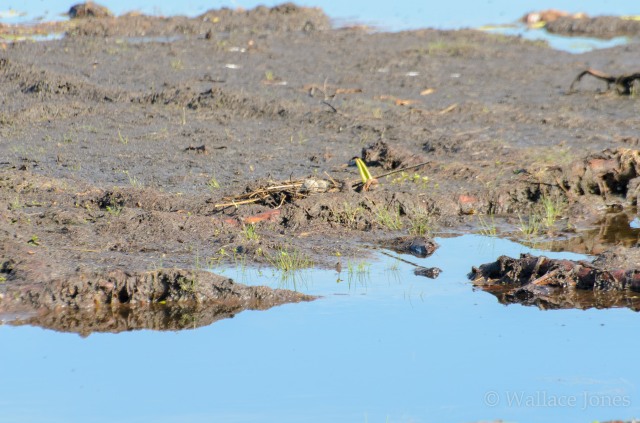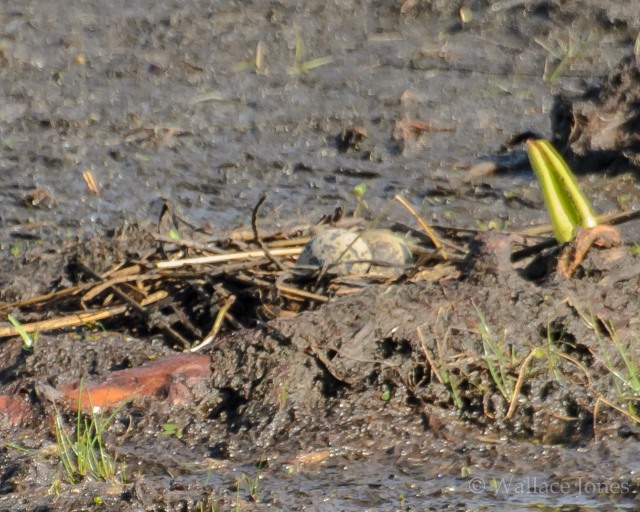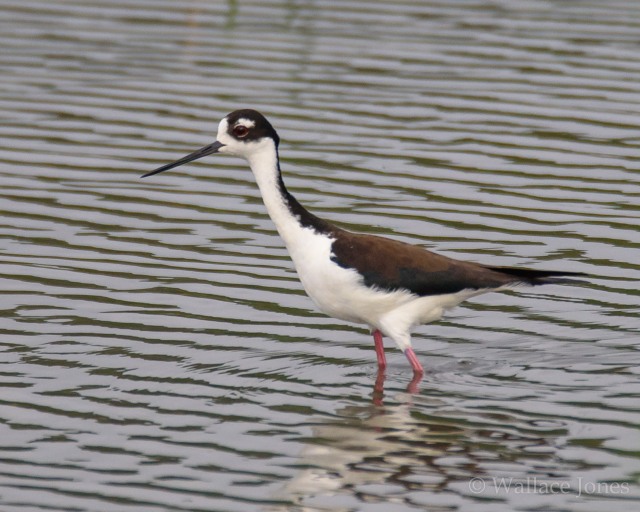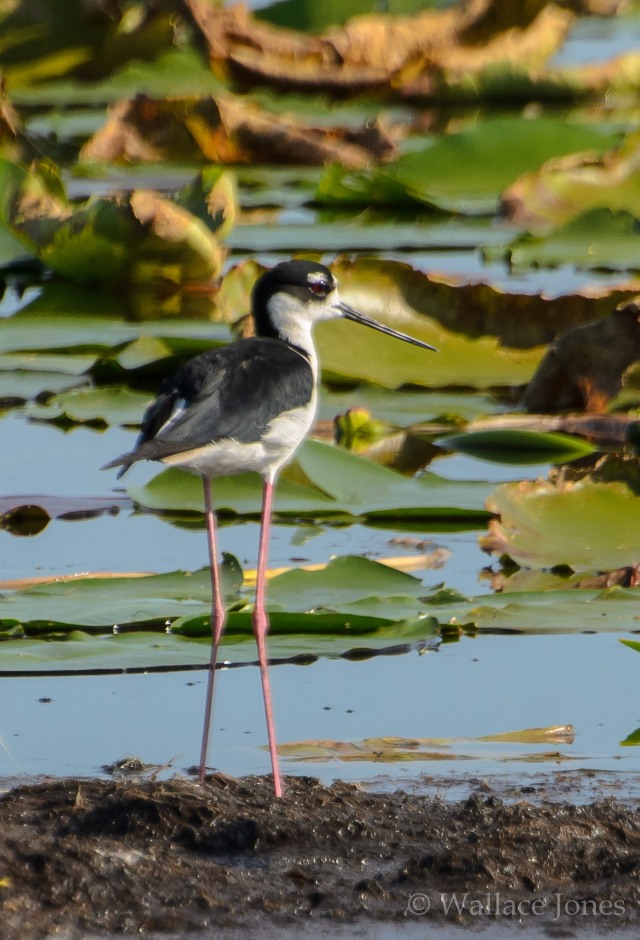Black-necked Stilt
Himantopus mexicanus is a small-bodied but somewhat tall shorebird which inhabits shallow wetlands looking for small invertebrates. Found in both fresh and salt water habitats, the average adult is about 14 inches (37 cm) long, mostly black above and white below. It’s long, spindly rosy-pink legs give the bird its name.
“But stilts are essentially waders; for wading they are highly specialized, and here they show to best advantage. At times they seem a bit wabbly on their absurdly long and slender legs, notably when trembling with excitement over the invasion of their breeding grounds. But really they are expert in the use of these well-adapted limbs, and one can not help admiring the skillful and graceful way in which they wade about in water breast deep, as well as on dry land, in search of their insect prey. The legs are much bent at each step, the foot is carefully raised and gently but firmly planted again at each long stride. The legs are so long’ that when the bird is feeding on land it is necessary to bend the legs backward to enable the bill to reach the ground.” – Arthur Cleveland Bent, Life History of the Black-necked Stilt, Smithsonian Institution, monographs published 1920-1950
Gini and I have delighted over the years anytime we have encountered this delicate-looking bird. One of our more memorable observations was watching a group of around a dozen stilts on a brisk windy day along the Texas coast at San Bernard National Wildlife Refuge. Nesting season was approaching and territories were being staked out and defended, noisily. Birds were flapping, flying, feeding, napping – little clouds of black, white and pink all across the salt marsh. Fantastic!
As part of a Florida breeding bird atlas, I was privileged to observe one nesting site containing over 130 nests contained within less than one acre of ground. Another day of discovery by boat located a nesting pair of stilts in a small lake with eggs on a bare patch of mud.
Whether flying, nesting, feeding or sleeping – these frail-looking birds with such long legs continue to be fascinating!
Nap time.

1/3200, f/8, ISO 1000, Nikon D750, Tamron 150-600 @500mm
Stilt eggs.

1/400, f/11, ISO 800, Nikon D7000, Nikkor 70-300 f/4.5-5.6 @300mm

1/400, f/11, ISO 800, Nikon D7000, Nikkor 70-300 f/4.5-5.6 @300mm
Immature stilt.

1/3200, f/8, ISO 1250, Nikon D750, Tamron 150-600 @420mm
Adult Black-necked Stilt.

1/1600, f/7.1, ISO 1800, Nikon D750, Tamron 150-600 @600mm
Size comparison with Great Egret. About 14 inches (37 cm) for the stilt to about 40 inches (100 cm) for the egret.

1/3200, f/8, ISO 1000, Nikon D750, Tamron 150-600 @460mm

1/800, f/11, ISO 720, Nikon D7000, Nikkor 70-300 f/4.5-5.6 @300mm

1/3200, f/8, ISO 1000, Nikon D750, Tamron 150-600 @550mm

1/1000, f/8, ISO 250, Nikon D750, Tamron 150-600 @600mm

1/3200, f/8, ISO 900, Nikon D750, Tamron 150-600 @420mm

1/1250, f/7.1, ISO 3600, Nikon D750, Tamron 150-600 @600mm

1/1250, f/11, ISO 1400, Nikon D750, Tamron 150-600 @600mm
If you’re lucky enough to live where Black-necked Stilts can be found, try to spend a little time observing them. Pack a lunch. They can be addictive.
Enjoy your search for a natural place and come back for a visit!
What lovely creatures! I have only seen stilts a couple of times here in New Zealand but always look for them! Your photos are really great.
Feel free to share at My Corner of the World
LikeLike
Hello, Betty! Thank you for such a nice comment. Aren’t they beautiful birds?
LikeLike
Those long legs are amazing, and such an appropriate name for these birds. I love Bent’s species descriptions. I have most of his series (reprints of course).
LikeLike
They are fascinating to observe! I totally agree about Bent’s word pictures. Wonderful!
LikeLike
Avocets and stilts are an eternal source of fascination, but we have to travel so far to see them we don’t often have the pleasure. And that is under normal circumstances, let alone the difficulties caused by Covid-19. I had hoped to be seeing Pied Stilts and Red-necked Avocets in Australia in July, with a reasonable chance of Banded Stilt too, but the Coronavirus scuttled those plans. Maybe next year…..
LikeLike
Ahh, the best laid plans of mice and birders …..
We are all hoping for a return to “birding as usual”! Hope it’s sooner rather than later.
LikeLike
What a wonderfully illustrated and enlightening post, Wally! Those legs look impossibly long and slender, and I’ve occasionally found myself wondering how any sort of control mechanism can run down legs like that in order to operate the feet at the end of them, let alone have any degree of management of the articulation of the leg joints. Thank you for arousing my curiosity once more!
All’s well here and I hope that it continues to be so there with you both – take good care – – – – Richard
LikeLike
These birds appear so ungainly and delicate, and yet have a subtle beauty which remind me of a ballerina.
We’re both doing great! Another weekend is almost here. Birding! Bugging!
Thank you for the kind remarks, Richard. All our best to you and Lindsay.
LikeLike
They are addictive and strikingly elegant, I just love those long, pink legs! Great shots!
LikeLike
Thank you very much, Donna!
LikeLiked by 1 person
What cool birds! Those legs go on forever. Wonderful photos!
LikeLike
Many thanks, Karen.
LikeLike
Nice work with the pictures Wally. These things are pretty scarce here in the UK where of course we know them as Black-winged Stilt (Himantopus himantopus) virtually indistinguishable. Seen lots in the Med and where I am always struck by their improbably long legs and knock-knees. But it’s a great species to watch in action as you show.
We have rain today, a change from the recent Florida type weather experienced in the last month. All that was missing was a dip in your outdoor swimming pool.
Take care you both.
LikeLike
Thank you, Phil. We are in an early “summer thunderstorm” cycle. Storms begin precisely at 2:00 and fade away at sunset. Humidity level and heat results in a constant steam bath. I love it.
Hope your bid for freedom from your oppressors is going well.
All the best.
LikeLike
Hello, Beautiful series and a great post on the Black-necked Stilts. Wishing you a happy day and week ahead!
LikeLike
Hi, Eileen, and thank you!
LikeLiked by 1 person
Great shots of the families. They can be so skittish.
LikeLike
They sure can be! Thank you, Dina.
LikeLike
Great info and photos, Wally – thanks for posting!
LikeLike
Thanks, Ed!
LikeLike
We have them here too (Portugal) but “ours” are a little different. The head and neck are completely white.No patches above the eye.
As for the behaviour it is like you said, they are fearless on nesting season.
Thank you for sharing and also for the settings on the photos.
LikeLike
Obrigado, Jorge! Aren’t they interesting birds? We really enjoy watching them teaching new chicks to hunt.
LikeLike
Gorgeous images of a gorgeous bird! We get the occasional Black-winged variety here in the UK but mostly they are on the continent.
LikeLike
Thanks, Brian. We’re fortunate here as they visit our nearby coasts as well as our shallow interior wetlands.
LikeLiked by 1 person
Totally fascinating.
I loved the size comparison shot too.
Many, many thanks.
As always.
LikeLike
Thank you, EC. Hope all is well with you.
LikeLike